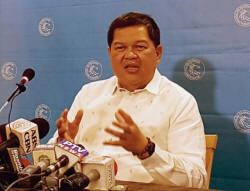|
Incoming Philippines central
bank chief says concerned about rapid credit growth
 Send a link to a friend
Send a link to a friend
 [June 14, 2017]
By Karen Lema [June 14, 2017]
By Karen Lema
MANILA
(Reuters) - The Philippine central bank is closely watching the rapid
pace of domestic credit growth, even though it is being driven by
legitimate demand, the incoming governor said on Wednesday.
"We're not being complacent about it," Nestor Espenilla, who takes the
helm of the central bank next month, moving from his current role as
head of banking supervision, said in an interview.
Bank lending in the Southeast Asian nation has been rising at a
double-digit pace for at least two years now. In April, it grew an
annual 19.2 percent, with the bulk of loans going to real estate,
manufacturing and information and communication.
"The challenge for an economy like the Philippines is we are in catch up
mode, so there is legitimate demand for credit and growth, you cannot
suppress that. But one thing done too rapidly may also lead to
mistakes," Espenilla said.
"We are closely monitoring these developments. These can lead to
problems if credit is supporting businesses that may be more vulnerable
to cyclical turns."

The rapid rise in credit growth, along with the double-digit rise in
investment growth and a stellar pace of economic expansion, have fueled
concerns of overheating and sustainability.
The Philippines remained one of Asia's fastest-growing economies in the
first quarter, with gross domestic product rising an annual 6.4 percent,
marking 73 quarters of uninterrupted growth. It is targeting growth of
between 6.5 percent and 7.5 percent this year.
Some economists have said current economic conditions warrant an
increase of as much as 50 basis points in interest rates in the second
half to tame overheating pressures.
[to top of second column] |

Incoming Philippine Central bank Governor Nestor Espenilla speaks
during a news conference at the Bangko Sentral ng Pilipinas in
Manila, Philippines May 9, 2017. REUTERS/Karen Lema

But
Espenilla said the direction of the central bank's monetary policy would depend
on consumer price expectations, and based on its projections, inflation is
expected to fall within this year and next year's target of 2 percent to 4
percent.
"We
are inside the inflation path," Espenilla said, adding that prices of fuel,
energy and food remain well-behaved.
Annual inflation eased 3.1 percent in May, to its slowest pace in four months.
Espenilla said the Philippine economy was in "good shape" and should stay that
way, given the government's big-spending overhaul.
The Philippines is pinning growth plans on higher infrastructure spending to
create jobs, stimulate the economy and attract foreign investors put off by high
power prices and poor roads and ports.
Amid a robust economy and tame inflation, the central bank is likely to keep its
benchmark interest rate <PHCBIR=ECI> steady at 3.0 percent when it holds its
next policy meeting on June 22.
(Reporting by Karen Lema; Writing by Manolo Serapio Jr.; Editing by Raju
Gopalakrishnan and Clarence Fernandez)
[© 2017 Thomson Reuters. All rights
reserved.] Copyright 2017 Reuters. All rights reserved. This material may not be published,
broadcast, rewritten or redistributed.
 |